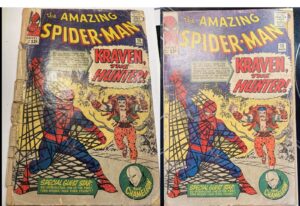Illustrated History of Comic Pressing
Comic books have captivated audiences for generations, transporting readers to fantastical worlds where superheroes battle villains and ordinary individuals embark on extraordinary adventures. Beyond their captivating narratives, comic books hold another secret to their enduring allure: the practice of comic book pressing. This behind-the-scenes art form has played a pivotal role in preserving the integrity and value of comic book collectibles. In this authoritative article, we delve into the history and purpose of comic book pressing, uncovering the techniques that have safeguarded these treasures for enthusiasts and investors alike.
Origins of Comic Book Pressing
The roots of comic book pressing can be traced back to the early days of comic book collecting in the mid-20th century. As the popularity of these colorful publications surged, collectors began seeking ways to maintain the pristine condition of their beloved issues. At the time, no formalized technique existed for restoring comic books to their original splendor. However, the concept of pressing itself was not entirely new; it had been utilized in the world of philately (stamp collecting) for many years before its application in the comic book realm.
The Pioneers of Comic Pressing
One of the pioneering figures in the early comic book pressing scene was Robert Bell, who established the first known comic book pressing service in the 1970s. Bell’s expertise and dedication to the craft laid the groundwork for modern pressing techniques. Over the following decades, various other pressing professionals emerged, contributing their own refinements and insights into the process.
The Art and Science of Comic Pressing
Comic book pressing, as the name suggests, involves applying carefully controlled pressure and heat to a comic book to remove or reduce defects that may mar its condition. These defects can include spine rolls, creases, folds, and other imperfections. The process is delicate and requires skilled hands to ensure no further damage occurs during the pressing procedure.
Pressing begins with a meticulous inspection of the comic book’s condition, identifying areas that need attention. The comic is then placed between specialized materials, often comic book backing boards or plates, various types of paper or release material between the book cover and boards. Next, the comic is exposed to controlled heat and pressure, usually within a press specifically designed for this purpose. The process aims to relax the fibers of the paper and release unwanted imperfections, thereby restoring the comic to a more appealing appearance.

The Purpose of Comic Book Pressing
Comic book pressing serves several essential purposes that appeal to collectors, enthusiasts, and investors alike:
- Preservation of Value: By eliminating or reducing visible defects, comic pressing helps maintain the book’s value over time. A well-preserved comic fetches a higher price in the collector’s market, making it a valuable investment for those who view comic books as a potential financial asset.
- Enhancing Aesthetics: For passionate collectors who take pride in their collections, pressing provides an opportunity to restore a comic’s aesthetic appeal. A flawlessly pressed comic book not only looks more attractive but also offers a sense of satisfaction to the owner.
- Grading and Authentication: Comic book grading companies often require comics to be in their best possible condition for assessment. Pressing allows for better grades, increasing a comic’s desirability among collectors and investors.
- Appreciation of Artwork: Comic books are, in essence, works of art. By pressing a comic and removing distracting defects, collectors can better appreciate the intricate artwork and storytelling within the pages.
-

Amazing results are possible!
Transparency and Controversy
Despite its evident benefits, comic pressing has not been without controversy. In the early days popular opinion was somewhat split, with one camp feeling pressing was a damaging form of restoration, and the other embracing this newish technique. These days pressing has become common practice and very widely accepted
Conclusion
Comic pressing is an integral aspect of the dynamic world of comic book collecting. Through its history, this practice has evolved from a rudimentary concept to a refined and highly skilled art form. While controversy surrounding pressing lingers, when done with transparency and expertise, it remains a valuable tool for preserving the integrity and value of comic book collectibles. As comic books continue to captivate the hearts of enthusiasts and investors worldwide, the art of pressing will undoubtedly play a significant role in safeguarding these cherished treasures for generations to come.


